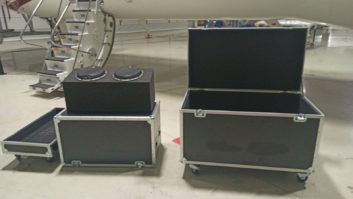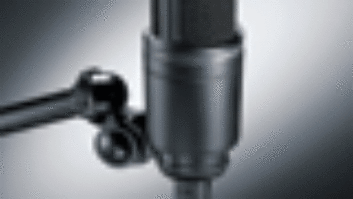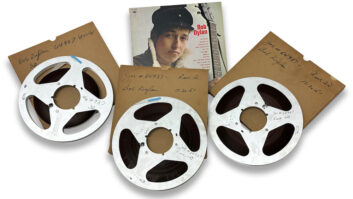Note to readers: An active discussion on this topic, whichincludes information about the musicians’ earplugs I mention in thearticle, is underway in the Talkback section of Mixforums.com. Anyone can read theposted messages, but if you want to add to the discussion, you mustbecome a member of Mixonline. Membership is free, and takes only aminute. See you there! — Paul Lehrman
What do you call it when you hear noises that aren’t really there?No, I’m not talking about what happens when you drink too much, or whenall that LSD you swallowed years ago flashes back at you. I’m talkingabout the whistles, rings, whooshing sounds and other aural artifactsthat are associated with a head injury, high blood pressure, or takingcertain medications (like aspirin), or hearing damage. It’s thecondition known as “tinnitus,” which doctors like topronounce “TIN-uh-tis,” while the rest of the world says“tin-EYE-tis.” With tinnitus, the ears seem to be pickingup sounds that don’t exist externally. It takes many forms and hasmany, many causes. There was an excellent article on the subject by BobMcCarthy in the January 2001 Mix, and if you’re interested inthe subject, you should go back and take a look at it (of course, it’son mixonline.com).
About a year ago, all of a sudden I got very interested init, because all of a sudden I got it. And I also got pretty scared.
For most of my post-adolescent life, I was quite sure I had escapedthe fate of so many of my fellow ’60s and ’70s rock ‘n’ rollers,managing to avoid any damage to my hearing from years of playing in andlistening to bands that were, let’s face it, too damn loud. These days,at the levels I typically listen to music, both for pleasure and forbusiness, it seems unlikely that I’m going to do anything further toscrew up my ears. The bulk of my studio work is film scoring, and Iusually work at relatively quiet levels, because I figure that’s theway it’s going to end up anyway when the mixing guys are done withit.
But about a year ago, I had a chance to do a score for an old silentfilm, and a pretty raucous score it was. I spent several days on it,monitoring at uncharacteristically loud levels. One day, after a fewhours of sitting in one position, my back started to hurt a bit, so Idid what I always do under such circumstances: I got up, took a longstretch and walked over to the bathroom to get a couple of ibuprofen.That night, before I went to bed, I popped a couple more of the pills,just to make sure I wouldn’t have trouble sitting through the nextday’s session.
Imagine my surprise when I awoke in the morning and discovered myears were ringing. Well, actually they weren’t ringing, but somethinginside of them seemed to be. It sounded like a sine wave generator upat around 8 kHz or so, and it was in both ears and quite constant.Imagine my further surprise when the ringing lasted all day and intothe next. Whenever this happened to me before — usually because Iwas at a really long, loud concert, without any ear protection,something I haven’t done in years — it never lasted more than acouple of hours.
Was it the ibuprofen, which, like aspirin, can cause a ringing inthe ears, or was it the unusually high levels that I’d been listeningto? Or was it the combination of the two or some other medications Ihad been taking? But the real question, the one lurking underneath allthe others, was: Had I done something to myself that had permanentlydamaged my hearing?
Let’s step back a minute. Like most folks past 30, especially men,my hearing is not as acute as it once was. When I was working in theelectronic music lab in college, I would often test myself, seeing howhigh I could get the old Heathkit oscillator to go (without looking atthe dial) before I couldn’t hear it any longer. It was usually, I wasproud to see when I turned around, up around 22 to 23 kHz. When Iworked in radio a few years later, I was the only guy in the place whocould hear the 20kHz track on the Magnetic Reference LaboratoryReproducer Test Tape. And for a long time, I could walk into any room— heck, any house — and tell you if a television set wason, because I could hear the 15,750kHz whistle that the fly-backtransformer made.
But as we get older, our high-frequency hearing drops off. It’snormally an extremely gradual thing, so we don’t notice it. One day inthe ’80s, during a period when I was reviewing a lot of high-endrecordings for consumer magazines, I was checking out my system with atest CD and discovered, to my dismay, that I couldn’t hear the 20kHzband. A few years later, I realized that the only way I could tell if aTV set in a room was on was to look at it. And for some reason, I can’thear my wife as well as I used to when she shouts from her office onone end of the house to my office on the other end. I don’t think it’sbecause our house is growing bigger.
Fortunately, I really haven’t had too much trouble resigning myselfto the fact that, like sliding head-first into home, diving from the5-meter board or hitchhiking up the East Coast, hearing 20 kHz was justone of those things I was never going to do again. My hearingperception, on the other hand, seems to have improved over theyears, which makes sense. Although being able to hear high frequenciesis certainly an important part of it, aural perception is very much aproduct of knowledge, smarts and experience, which is why there areplenty of guys well into their ’60s who are still great mixingengineers. Maybe I can’t hear the sampling clock on a CD player, but Ican still tell you who’s playing the wrong note in a 20-piece big band,or at what bar the drummer is coming in just a hair late, or exactlywhere to set the mid-band EQ to bring the vocal up out of the mud. AndI think I can do all of these things a lot better than when I wasyounger.
So you can see why I might be terrified when the sudden noise in myears wouldn’t go away. After the second day, I called my primary-caredoctor, and he said it was probably the fault of the ibuprofen and thenoise would go away in a few days. After a week, when it was stillgoing strong, I called another doctor, a pharmacologist. She said itprobably wasn’t the drugs, but the result of all that loud music I’dbeen listening too, and if I was lucky, it would go away in a few moredays.
But it didn’t. After two weeks, I was beginning to get reallynervous. I started stuffing my ears with cotton whenever we went tohear any amplified music, which made me feel worse, because the musicsounded so awful and the ringing actually seemed louder. Then I startedplugging my ears whenever I got into the car. A fire engine would go byand I’d put my head down between my knees as if I was expecting a bombto drop. After a month, my wife was ready to kick me out of thehouse.
I sent an e-mail to the Hearing Education and Awareness Foundationin Los Angeles, a group that specializes in treating musicians withhearing problems, and also happens to be one of the organizations thatbenefits from the TEC Awards banquet and other Mix Foundationactivities. It has a great Website (hearnet.org) that lists affiliatedhearing specialists all over the country. Unfortunately, there’s no oneon that list less than 100 miles from me. Fortunately, Kathy Peck, oneof the two founders of the organization, e-mailed me back the same dayand gave me the name of an audiologist at the Massachusetts Eye &Ear Infirmary, which (except in rush hour) is only about 15 minutesfrom my house.
I got an appointment right away (mid-afternoon) and met Dr.Christopher Halpin, a pleasant fellow around my age, who, as it turnedout, was also an electronic music freak when he was in college. Inbetween feeding me sine waves, recorded speech and various other typesof noises through a pair of heavy headphones, he and I had a grand timetalking about the bad old days of drifting oscillators, finicky 16-stepsequencers, lousy speakers and roaring EMT plate reverbs.
Chris gave me a complete workup, and when it was over, he handed mea sheet of paper with the results. “Hearing is normal through 3kHz,” it read, with “a very mild symmetric sensory lossabove that.” “Typical for a man your age,” he said.“You’re right in the middle of the range.”
The graph he plotted for me, with 1 kHz at zero, went down 15 dB at4 kHz, 20 dB at 8 kHz, and 50 dB at 12.5 kHz. That seemed like quite adrop-off, and nobody I know would tolerate a microphone that did that,but he said it was perfectly normal for human ears. “What aboutabove 12.5k?” I asked him. “Oh, we don’t measurethat,” he replied, “because there’s no way for us tospecify a sound pressure level as a reference point. At thosefrequencies, the waveforms get affected by the construction of the earitself: You can get standing waves as small as the ear canal. Sinceeveryone’s ears are different, there’s no way to tell objectivelywhat’s going on.” This took me rather by surprise, but I had moreimportant issues to deal with.
Like, what the heck was causing my tinnitus? Chris’ reply was that,while he couldn’t tell what was causing it, he was pretty certain thatit was not caused by my recent studio sessions. “If you’ve beenlistening for years and years at loud levels, I’d say that could be afactor, but one loud mixdown session isn’t going to do it. Somethinglike that might cause a temporary threshold loss, and maybe a ringing,which recovers in a couple of days.” Decades’ worth of high SPLs,he explained, could damage the cilia, the frequency-sensitive,hair-like nerve endings that serve as our personal D/A converters; theyliterally break off. But that wasn’t my problem. If I did have anyhearing loss, and it wasn’t at all clear if I did, it was more thanlikely due to genetic factors. My grandfather, after all, was stonedeaf by the time he was 50. “But none of these factors arestrongly related to tinnitus,” Chris said as he shook his head.“Really, tinnitus is not an ear thing at all — it’s aphantom percept.”
After I gave him a hug, he suggested that if I wanted to learn moreabout tinnitus, and maybe pin down the cause, I should make anappointment in the same hospital with Dr. Robert Levine, anotoneurologist (“oto” means “ear”), who isrecognized as one of the world’s tinnitus experts. Before I left theclinic, I bought a pair of musician’s earplugs for $25 that herecommended. Now I didn’t have to carry cotton balls around with me,and I could go into a club and still hear the music, without worryingabout frying my cilia.
Dr. Levine’s office, to my dismay, told me he only saw patients oneday a week, and he was booked solid for six months. I made anappointment anyway and told the secretary that if anything opened up(not during rush hour), she should call me. Three weeks later, aftersomeone had canceled, I was sitting in Dr. Levine’s office. And I foundout why he was so hard to see: He ended up spending almost two hourswith me.
Dr. Levine is a researcher as much as a practitioner, and hismission is to find out how tinnitus affects people. He asked me allabout my ethnic background (which was almost identical to his, itturned out — we could be cousins), medications I was taking, pastinjuries and operations, family medical history, the nature of thesound I was hearing and dozens of other questions. I noticed that hisoffice seemed to be rather noisy, and I looked around for the source ofthe sound: There was an object on the floor, about the size and shapeof a small birthday cake, which was emitting a sound like rushingwater. It was a sound masker — an acoustic dither generator. Hesaw my glance and smiled. “I have it, too,” he said.
He cataloged some of the many causes of tinnitus. Besides exposureto loud sound, there are ear infections, wax buildup, benign tumors,drugs (a common sedative, alprazolam, can, in different people, be thecause or the cure for the condition), and stress: physical,biochemical, environmental or emotional. He moved my head, arms andhands into various odd positions and asked me whether the soundchanged. He was delighted when I reported that sometimes the pitch ofthe sound changed, and that sometimes the level changed. Apparently,very few of his patients can tell (or articulate) the differencebetween the two.
I was delighted when I discovered that if I locked my fingerstogether in front of me and tried to pull my hands apart, the intensityof the sound would diminish noticeably. Not that I could walk aroundall day like that, but it meant I could feel that I had at least a tinybit of control over the thing.
So, after two hours, what did this leading scientific authority haveto say about what was causing my problem? He shrugged and said that hereally had no idea. The good news was, he agreed with Dr. Halpin thatit didn’t have anything to do with the sound levels I had beensubjecting myself to. The bad news was that, although he thought itmight go away by itself, “I wouldn’t want to bet on it.” Hesuggested getting a noise-making machine like his, or keeping musicgoing in the background all the time. And he did have one optimisticthing to say: “In three months, you’ll hardly noticeit.”
He was right. I still have the noise in my head a lot of the time,but I really only notice it occasionally, and it rarely bothers me.(Although, at the moment, because I’m thinking about it, it’s prettyloud.) But the whole experience of learning about tinnitus and whataudiologists know and don’t know has actually brought to my mind awhole new set of questions. Is research in audiology so far behind whatwe in the audio profession consider to be current state-of-the-art thatwe know more about how frequencies in the top octave of our range aresupposed to behave than audiologists do? What happens if you look at itthe other way around? How important is it really that our signal chainsbe dead flat up to 20 kHz, because most of us can’t hear anywhere nearthat high, and audiologists can’t measure how we respond to thosefrequencies? And what about the world above 20k? What is itsrole in the way we perceive music and sound — if it has any?
I’ve started pursuing these questions, and I’ve been coming up withsome surprising answers, which I’ll tell you about in a future column.In the meantime, keep your levels down and your ears protected.
Paul Lehrman is a composer, educator and Mix’s online editor. Hispersonal site is paul-lehrman.com. He can be reached at [email protected]. Join adiscussion about tinnitus at Mixforums.com.






